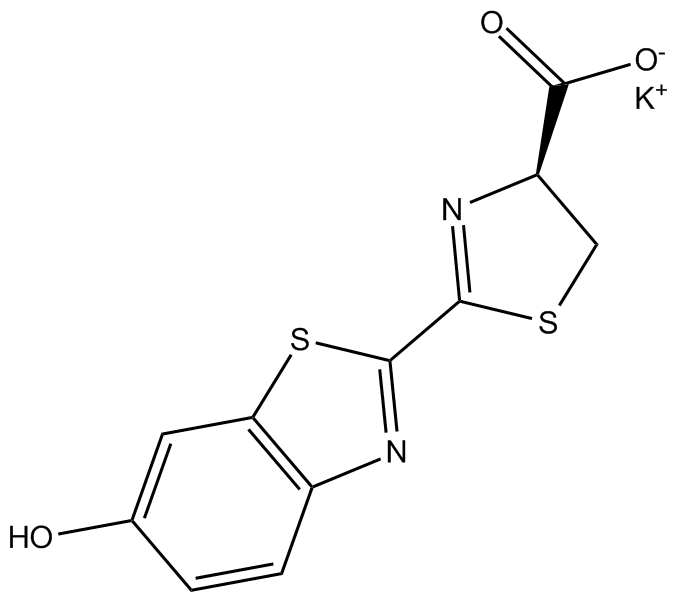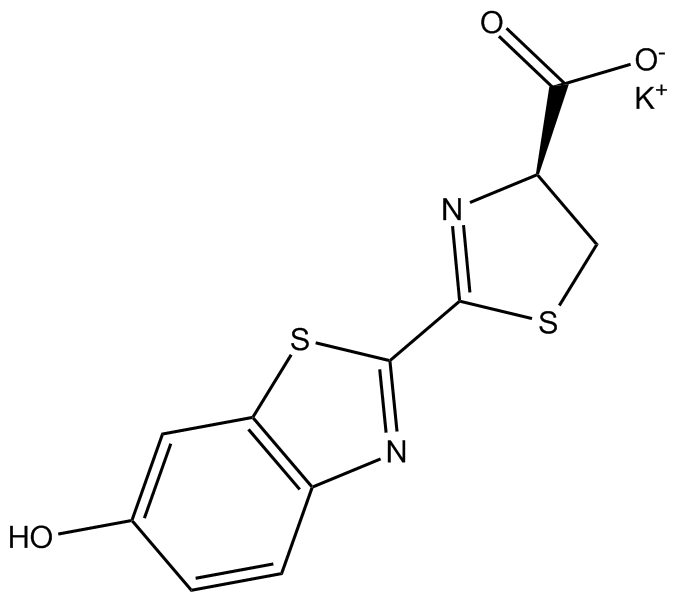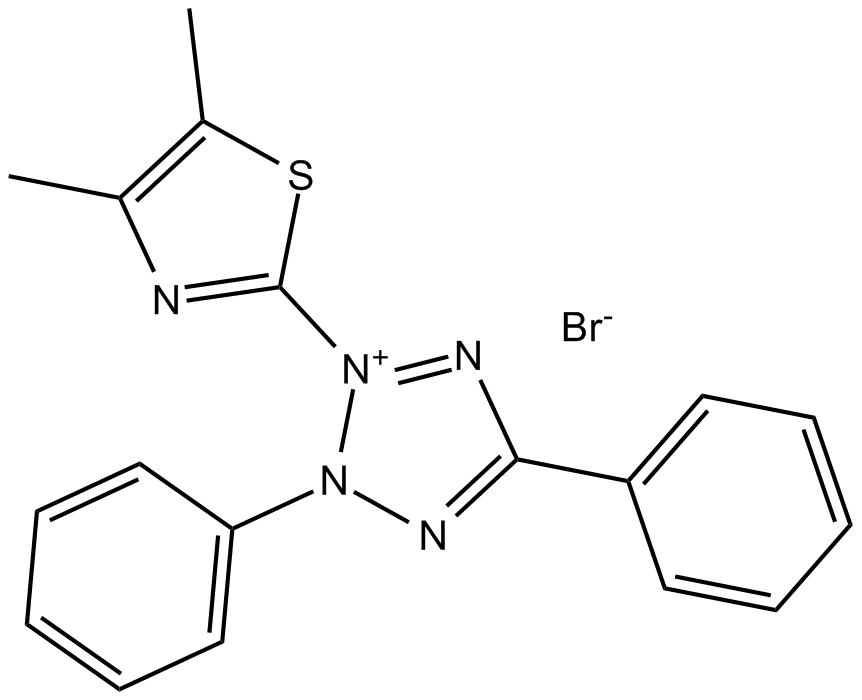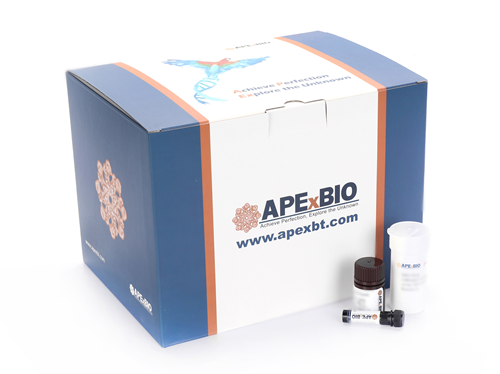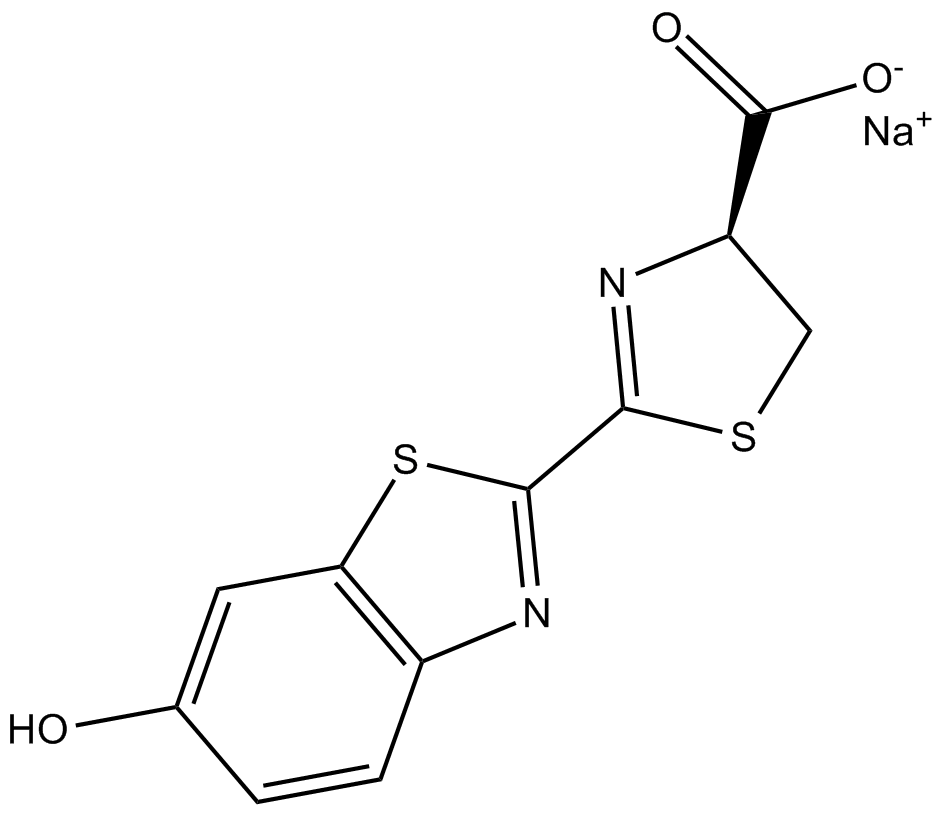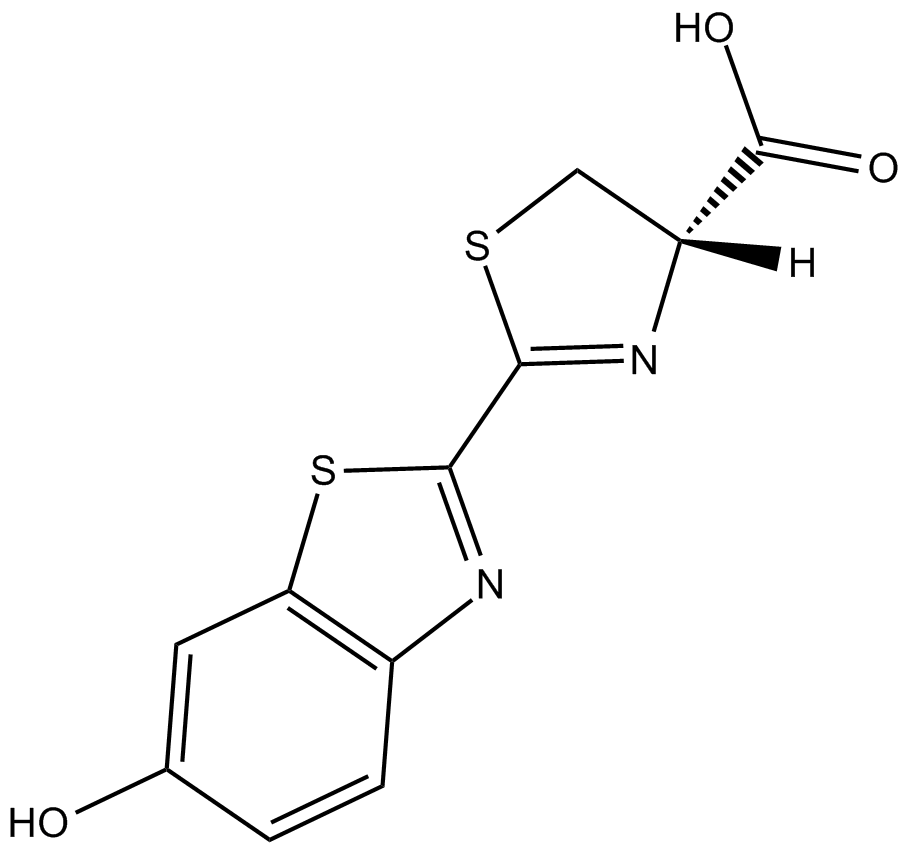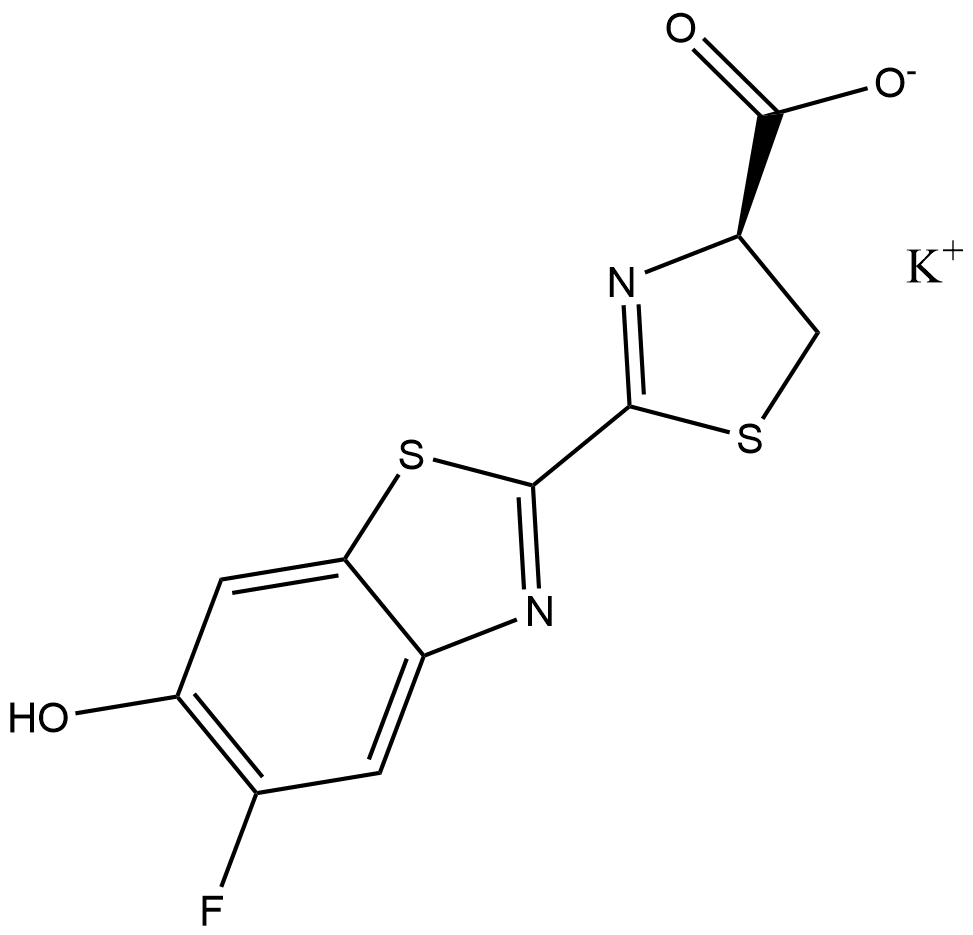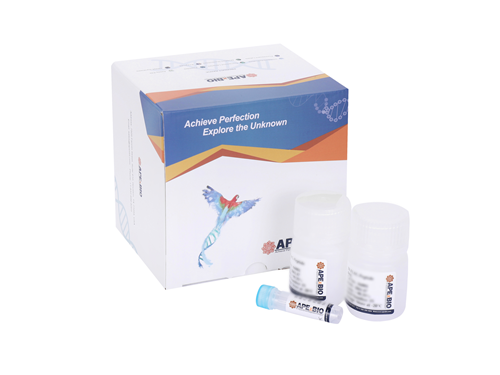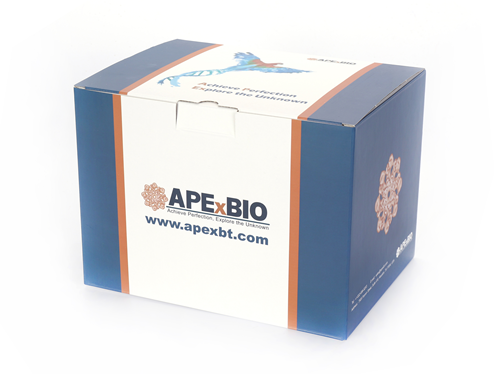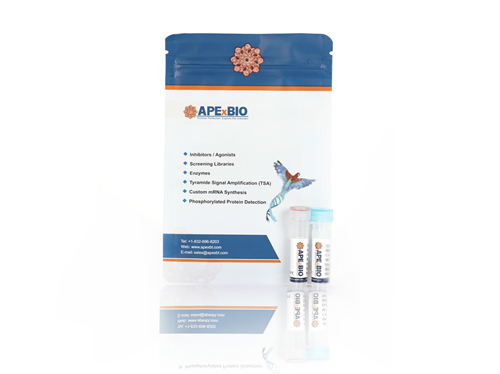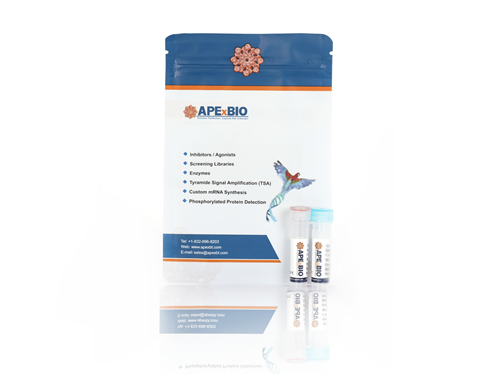D-Luciferin (potassium salt)
D-Luciferin is a substrate of firefly luciferase. Firefly luciferase can catalyze the oxidative reaction of D-Luciferin in the presence of ATP, Mg2+ and molecular oxygen, emitting a yellow-green light. Luciferin is widely utilized in biotechnology, particularly for in vivo imaging studies. It is used to track tumor cells, stem cells, or pathogens in animals like rats and mice. By injecting luciferin, researchers can monitor disease progression or treatment efficacy in real-time and non-invasively via Bioluminescence Imaging (BLI). Luciferin is also used for in vitro assays, such as luciferase and ATP assays, reporter assays, high-throughput sequencing, and contamination detection.
The three common forms of D-Luciferin are free acid, potassium salt, and sodium salt. The free acid form needs to be dissolved in alkaline solutions such as KOH or NaOH. The potassium and sodium forms are soluble in aqueous buffer. So, potassium and sodium forms are more suitable for various biological experiments, such as in vivo imaging analysis and in vitro bioluminescence detection.
- 1. Jie Li, Shun Feng, et al. "Stress-specific adaptation of a non-betalain DODA homolog from pansy (Viola × wittrockiana)." Industrial Crops and Products Volume 238, 15 December 2025, 122373
- 2. Bohan Chen, Liming Gong, et al. "Improving the Treatment of Brain Gliomas Through Small-Particle-Size Paclitaxel-Loaded Micelles with a High Safety Profile." Pharmaceutics 2025, 17(8), 965
- 3. Zhijie Lian, Lingying Zheng, et al. "Breaking Endosomal Barriers: Thiol-Mediated Uptake Lipid Nanoparticles for Efficient mRNA Vaccine Delivery." J Am Chem Soc. 2025 Jul 22. PMID: 40694665
- 4. Yanyan Tao, Jingwen Chang, et al. "The research on cycloastragenol in the treatment of brain metastases from lung cancer: mechanistic exploration of radiotherapy sensitization and amelioration of brain injury." Front Med (Lausanne). 2025 Jul 4:12:1616894. PMID: 40687724
- 5. Shiqiang Dong, Lili Wang, et al. "CELF2 inhibits bladder cancer progression by decreasing the stability of CXCL5." Life Sci. 2025 Jun 1:370:123585. PMID: 40154776
- 6. Chuanmei Tang, Yexi Zhang, et al. "Modular Design of Lipopeptide‐Based Organ‐Specific Targeting (POST) Lipid Nanoparticles for Highly Efficient RNA Delivery." Adv Mater.2025 Mar;37(11):e2415643. PMID: 39924757
- 7. Menghua Gao, Jiafeng Zhong, et al. "Deciphering the Role of PEGylation on the Lipid Nanoparticle-Mediated mRNA Delivery to the Liver." ACS Nano. 2025 Feb18;19(6):5966-5978. PMID: 39899798
- 8. Dexiang Feng, Xiaoying Kang, et al. "Photochemical bomb: Precision nuclear targeting to activate cGAS-STING pathway for enhanced bladder cancer immunotherapy." Biomaterials. 2025 Jul:318:123126. PMID: 39884129
- 9. Jialiang Lin, Zesheng Sun, et al. "Glioma stem cell membrane-camouflaged photothermal nanozyme for synergistic antitumor via dual-targeted drug delivery across blood-brain barrier." Volume 507, 1 March 2025, 160181
- 10. Qinlin Deng, Huanhuan Lu, Dakun Liu. "Modulation of flowering by an alternatively spliced AGL18-1 transcript in Brassica juncea." The Crop Journal Volume 13, Issue 2, April 2025, Pages 456-467
- 11. Weixiang Gao, Kang An, et al. "Resolving the mRNA Encapsulation-Release Trade-off via Compensatory Forces in Engineered Ionizable Lipids." Adv Mater. 2025 Nov 16:e12235. PMID: 41243603
- 12. Jia-Ling Lin, Wen-Kai Wu, Gui-Bin Nie. "A dirigent protein redirects extracellular terpenoid metabolism for defense against biotic challenges." Nat Commun 16, 9270 (2025) PMID: 41115945
- 13. Bocun Yi, Zongyang Zhao, et al. "Antimony Exposure Induces Bladder Cancer Metastasis Via Activation of the SUMOylation-Dependent TGF-β/Smad2/3 Axis." Environ Res. 2025 Aug 12:122589. PMID: 40812700
- 14. Mengqing Gao, Minhui Shi, Hao Ding. "SUCLG1 deficiency-induced histone succinylation impairs oncogene expression in acute myeloid leukemia." Cell Rep. 2025 Aug 26;44(8):116147. PMID: 40811057
- 15. Lihaitian Wang, Xiaoli Liu, Feng Yu. "A bacterial effector protein targets plant ferredoxin-NADP+ reductase to promote infection." PLoS Pathog. 2025 Oct 30;21(10):e1013664. PMID: 41166410
- 16. Jiatao Li, Juan Feng, et al. "B cell lymphoma 6 promotes hepatocellular carcinoma progression by inhibiting tumor infiltrating CD4." NPJ Precis Oncol. 2024 Jul 1;8(1):139 </a></li>. PMID: 38956432
- 17. Wen-Kai Wu, Gui-Bin Nie, et al. "Regulation of Glandular Size and Phytoalexin Biosynthesis by a Negative Feedback Loop in Cotton." Adv Sci (Weinh). 2024 Jun 5:e2403059. </a></li>. PMID: 38840438
- 18. Hao liu, et al. "Animal models of brain and spinal cord metastases of NSCLC established using a brain stereotactic instrument." Heliyon. 2024 Jan 20;10(3):e24809. PMID: 38318004
- 19. Ting Li, Lin Chen, et al. "Chemotactic nanomotor for multimodal combined therapy of glioblastoma." Science China Chemistry Volume 67, pages 1277–1288, (2024)
- 20. Huan Chen, Ting Li, et al. "A nitric-oxide driven chemotactic nanomotor for enhanced immunotherapy of glioblastoma." Nat Commun. 2023 Feb 20;14(1):941. PMID: 36804924
- 21. Yaoshuai Zhang, Yongping Li, et al. "Experimental study of EGFR-TKI aumolertinib combined with ionizing radiation in EGFR mutated NSCLC brain metastases tumor." Eur J Pharmacol. 2023 Apr 15;945:175571. PMID: 36804545
- 22. Junjie Feng, Qinlin Deng, et al. "Brassica juncea BRC1-1 induced by SD negatively regulates flowering by directly interacting with BjuFT and BjuFUL promoter." Front Plant Sci. 2022 Sep 30;13:986811. PMID: 36247593
- 23. Zhen Wang, Miao Liu, et al. "Rapeseed ( Brassica napus) Mitogen-Activated Protein Kinase 1 Enhances Shading Tolerance by Regulating the Photosynthesis Capability of Photosystem II." Front Plant Sci. 2022 Jun 2;13:902989. PMID: 35720537
- 24. Xing Huang, Yan Huang, et al. "Loss of cell division cycle‑associated 5 promotes cell apoptosis by activating DNA damage response in clear cell renal cell carcinoma." Int J Oncol. 2022 Jul;61(1):87. PMID: 35642672
- 25. Jianjian Yu, Dan Hu, et al. "Hyperglycemia induces gastric carcinoma proliferation and migration via the Pin1/BRD4 pathway." Cell Death Discov. 2022 Apr 23;8(1):224. PMID: 35461311
| Storage | Store at -20°C, sealed storage, away from moisture and light |
| M.Wt | 318.41 |
| Cas No. | 115144-35-9 |
| Formula | C11H7KN2O3S2 |
| Solubility | insoluble in EtOH; insoluble in DMSO; ≥30 mg/mL in H2O; ≥30 mg/mL in H2O |
| Chemical Name | potassium (S)-2-(6-hydroxybenzo[d]thiazol-2-yl)-4,5-dihydrothiazole-4-carboxylate |
| SDF | Download SDF |
| Canonical SMILES | [O-]C([C@@H]1N=C(c2nc(ccc(O)c3)c3[s]2)SC1)=O.[K+] |
| Shipping Condition | Small Molecules with Blue Ice, Modified Nucleotides with Dry Ice. |
| General tips | We do not recommend long-term storage for the solution, please use it up soon. |
Quality Control & MSDS
- View current batch:
Chemical structure
